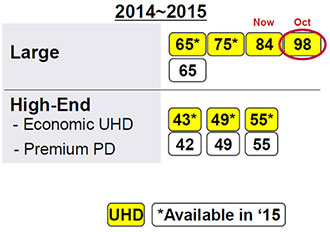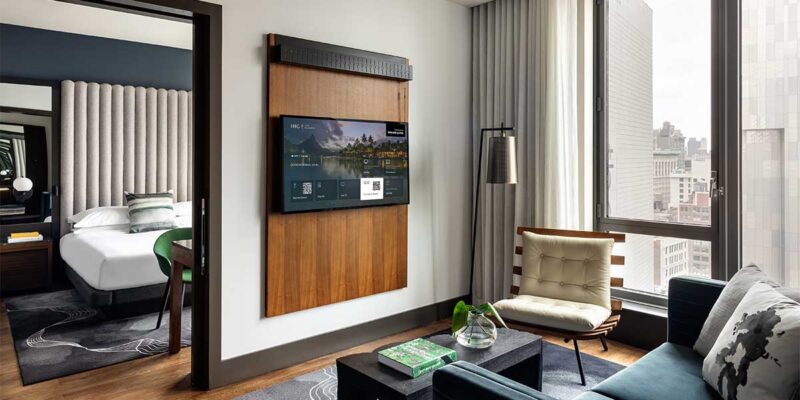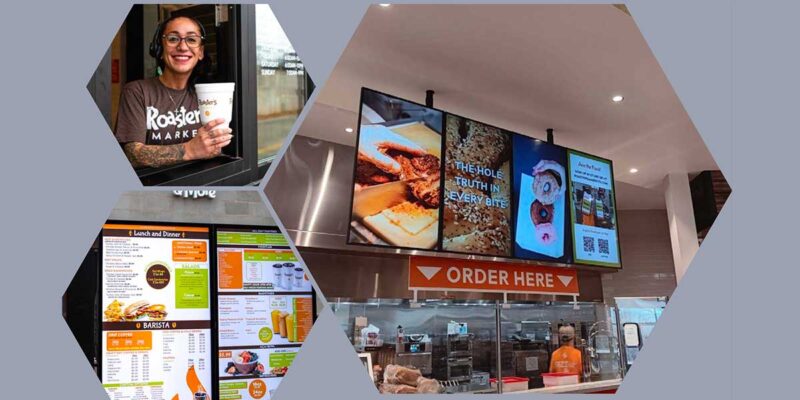LG Reveals Signage Display Product Plans
Just prior to InfoComm, we received a pre-briefing on LG’s plans for display products for the digital signage market. Now, we can tell you more about the company’s signage display plans.
In the briefing, the company started by noting key requirements for various market segments. For example, in the transportation segment, 24/7 operation and self diagnosis are key, whereas in Quick Serve Restaurants (QSR), remote management and automatic signal switching are important. Retail is often a cost sensitive market so 16/7 operation with 300-400 nits of brightness is the key to success. In Corporate/Education, larger panels with touch capability, along with interactive white boards seem to be the trend. In outdoor signage, there is a growing move toward higher brightness and higher operating temperatures.
Serving all these vertical markets can be a challenge as end users generally want to source a solution, not a series of component they have to configure and operate. LG can supply the display, media player and WebOS signage platform, but partners need to configure the content and network management piece, plus provide the installation, maintenance and service aspects of the project. Let’s take a look at what LG brings to the table.
While many signage solutions do use consumer-grade panels, players and other components, LG does offer commercial-grade solutions to serve these markets. In general, this means they use higher reliability components to achieve the 16/7 or 24/7 operation, plus add other features for the pro system integrator.
For instance, many of the commercial-grade displays include a high performance SoC, branded as SuperSign. This includes a 1GHz dual core CPU, 1.25GB of DDR3 memory, an internal hard drive (8/16GB) and the ability for additional storage via external USB drives. Running on this SoC is the WebOS platform, which can support programs and apps based on Android, Windows and iOS. That’s a really nice feature allowing end users to choose the applications they want, and use any mobile device to manage the content and network.

The latest version is SuperSign V (LG also offers a SuperSign Lite version for cost conscience buyers). New is the ability to create arbitrary configuration of display and have the content playback on them — even if the displays are rotating like a windmill. They have also enhanced the failover mode in case a media player goes down, to provide a secondary connection to the display (over DisplayPort), or via internal memory, to keep the sign running. Also new is an optional screen fault detection that places a little marker in the corner of the screen that is read by a local sensor. This alerts the operators if there is no content playing — a nice feature. In 2014, the some displays (LS75A/73B) will support OPS plug-in modules as well as wireless connectivity over Wi-Fi or Miracast (in 2015).
Built-in touchscreen support is available this year in 42-, 47-, 55- and 84-inch models and as an overlay next year in 32-, 42-, 47-, 55- and 65-inch screen sizes. LG uses spread IR technology for touch-enabled built-in models. “Unlike a traditional IR systems, our sensor technology uses a wider angle on the emitters so that the IR beams strike multiple receivers, giving better touch accuracy and improved response time,” the company explained in an email. “Our sensors support up to 10 simultaneous touch points.”
The overlay option uses the same technology, but will be added next year so existing panels can be upgraded to add touch capability, which can be field installed. “LG developed this solution in response to our customers who wanted the ability to add touch at a later date if their needs change, and to provide better flexibility from a support aspect as well. If a touchscreen should fail, it can be quickly replaced with an overlay where an integrated solution might need to be sent back to a service center. The same can be said if a display should fail. A fresh display can be shipped in and integrated in the field, rather than having to wait for integration at a service center,” explained the company.
In terms of displays, LG will introduce a number of UHD models in 2014 and 2015, as shown in the graphic. Currently, only the 84-inch model introduced a year ago is available with the 98” model coming this October. The 84WS70MS is media player compatible with attachable external media players, MP700 and MP500 (sold separately). The slim LG media players can be installed in the back without taking up additional space. Currently, HEVC support with OPS is not available on the current 84-inch model.
Next year however, the line-up will expand considerably with 43-, 49-, 55-, 65- and 75-inch UHD models available.





